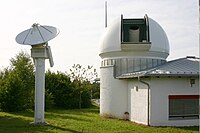
Photo from wikipedia
Abstract The Satellite Laser Ranging (SLR) technology is used to accurately determine the position of space objects equipped with so-called retro-reflectors or retro-reflector arrays (RRA). This type of measurement allows… Click to show full abstract
Abstract The Satellite Laser Ranging (SLR) technology is used to accurately determine the position of space objects equipped with so-called retro-reflectors or retro-reflector arrays (RRA). This type of measurement allows to measure the range to the spacecraft with high precision, which leads to determination of very accurate orbits for these targets. Non-active spacecraft, which are not attitude controlled any longer, tend to start to spin or tumble under influence of the external and internal torques and forces. If the return signal is measured for a non-spherical non-active rotating object, the signal in the range residuals with respect to the reference orbit is more complex. For rotating objects the return signal shows an oscillating pattern or patterns caused by the RRA moving around the satellite’s centre of mass. This behaviour is projected onto the radial component measured by the SLR. In our work, we demonstrate how the SLR ranging technique from one sensor to a satellite equipped with a RRA can be used to precisely determine its spin motion during one passage. Multiple SLR measurements of one target over time allow to accurately monitor spin motion changes which can be further used for attitude predictions. We show our solutions of the spin motion determined for the non-active ESA satellite Envisat obtained from measurements acquired during years 2013–2015 by the Zimmerwald SLR station, Switzerland. All the necessary parameters are defined for our own so-called point-like model which describes the motion of a point in space around the satellite centre of mass.
Journal Title: Advances in Space Research
Year Published: 2017
Link to full text (if available)
Share on Social Media: Sign Up to like & get
recommendations!